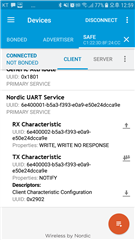My development environment is sdk15 s132 pca10040
The product concept provides central link 7, peripheral 1 on one 52832 .. 1 peripheral provides nus to work with smartphones 7 central communicates 7 52832 based on lbs.
Question 1: An error of NRF_ERROR_NO_MEM occurs in blcm_link_ctx_get () function. When I trace the cause, the variable values are as follows. max_links_cnt = 0x01; conn_id = 0x02 When BLE_GAP_EVT_CONNECTED occurs in the on_ble_peripheral_evt () function p_ble_evt-> evt.gap_evt.conn_handle = 0x2
Question 2: #define DEVICE_NAME "Church_Product" If the nus service is not available, the device name appears on the smartphone. However, if it include nus, device name is "Chur" only on my smartphone.
Please, reply.


